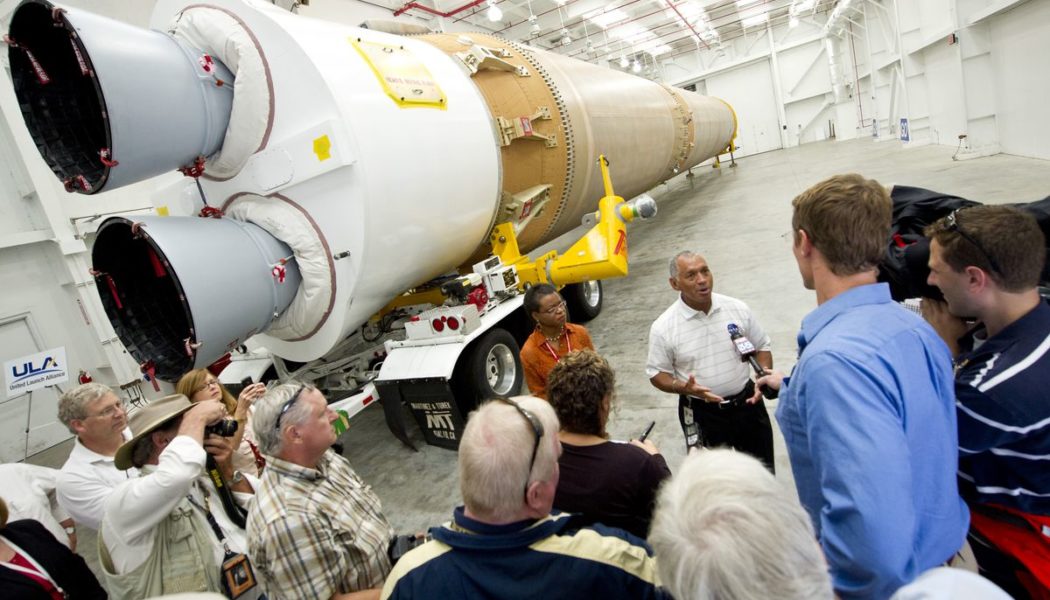United Launch Alliance won’t be selling any more of its workhorse Atlas V rockets, and it has stopped buying the launch vehicle’s Russian-made rocket engines for good, the company’s chief executive told The Verge. ULA’s decision sets up the retirement of one of the US government’s most trusted launch vehicles and is expected to mark the end for Russia’s iconic — but controversial — RD-180 engine, an engineering marvel and a core source of revenue for Russia’s space program.
“We’re done. They’re all sold,” CEO Tory Bruno said of ULA’s Atlas V rockets in an interview. ULA, a joint venture between Boeing and Lockheed Martin, has 29 Atlas V missions left before it retires sometime in the mid-2020s and transitions to its upcoming Vulcan rocket, Bruno said. The remaining Atlas V missions include a mix of undisclosed commercial customers and some for the Space Force, NASA, and Amazon’s budding broadband satellite constellation, Project Kuiper.
First launched in 2002, the expendable Atlas V launcher was the centerpiece vehicle that helped cement ULA’s near-monopoly on national security satellite missions and some of NASA’s biggest space exploration initiatives, including all of the agency’s robotic missions to Mars. But when the US sanctioned Russia over its annexation of Crimea in 2014, Congress directed the Air Force to end its reliance on Atlas V because of its Russian-made RD-180 engines. Current law requires the Space Force (which manages much of the launch-related duties that used to be under the Air Force) to stop using Atlas V for Pentagon launches by 2022.
:no_upscale()/cdn.vox-cdn.com/uploads/chorus_asset/file/22807140/123986661.jpg)
Bruno said three or four RD-180s are installed on Atlas V rockets for upcoming missions, and the rest are sitting in a warehouse. “We took early delivery, if you will, with the RD-180, so I can end that relationship and not be dependent upon [Russia] because that’s what Congress asked us to do,” he said. In all, the US has taken delivery of 122 RD-180 engines, generating billions in revenue for Russia’s space program.
The last six RD-180 engines were delivered to the US in April, Russia’s space agency, Roscosmos, has previously said. That month, Bruno’s Russian counterparts told the CEO that if ULA ever decides to buy more RD-180 engines in the future, they’d be willing to build more and sell. But with no plans for ULA to buy more, the RD-180 program will likely come to an end, Bruno said. He took Russia’s offer with a grain of salt, skeptical that Energomash, the state-owned manufacturer of the RD-180, would be able to restart its engine production line and testing regime after it closes.
A spokesperson for Roscosmos, which speaks on Energomash’s behalf, declined to comment on whether RD-180 production is ending. The space agency’s former director, Igor Komarov, said in 2017 that Roscosmos has had “requests from some countries that are developing launchers and their expertise in space” to use the RD-180 engine, but those prospective engine customers remain to be seen.
The geopolitics of the RD-180 engine wasn’t the only reality setting Atlas V back. The rocket struggled to compete with SpaceX’s Falcon 9, a cheaper reusable rocket that chipped away at ULA’s monopoly on government launch contracts. Though a recent win for the rocket came in April when Amazon revealed it picked Atlas V to launch its internet-beaming Kuiper satellites into space. The value of the deal wasn’t disclosed.
ULA has slashed the price for Atlas V missions from roughly $187 million to around $100 million as competition from SpaceX mounted, but it never closed in on Falcon 9’s launch price of roughly $62 million. Once a dominant force for national security launches, ULA now competes head to head with SpaceX for lucrative Pentagon launch contracts. Last year, Space Force awarded billions to ULA and SpaceX to launch 30 to 35 missions for the Pentagon between 2022 and 2027, with ULA getting 60 percent of the workload and SpaceX getting the rest.
For those Pentagon missions, ULA will mainly use its next-generation lower-cost Vulcan rocket, the replacement for Atlas V. Vulcan will use BE-4 engines under development by Jeff Bezos’ Blue Origin — but those engines have been delayed, further pushing Vulcan’s launch debut from late 2021 into early 2022. Development issues with the engine’s turbo pump and excessive vibrations that would occur while the engine was test-firing were the main factors for the delays, Bruno said, but they’ve since been resolved. “What is pacing us now is just building hardware,” he said, expecting delivery of the first flight-ready engines by the end of the year.
The Space Force is weighing whether it’ll need to come up with “backup options,” should BE-4 delays continue into next year, Gen. Jason Cothern, the deputy commander of Space Force’s rocket acquisition unit, said Wednesday. Those options could include shifting some of Vulcan’s workload under its share of Pentagon launches to SpaceX, but officials are waiting to make a move on any contingencies until next year to see how the final chapter of BE-4 development plays out. “Obviously we’re concerned, but we’re engaged with ULA and they’re heavily engaged with Blue Origin to bring it along,” Cothern said, adding “we’re cautiously optimistic” that the flight-ready BE-4 engines will be delivered to ULA by year’s end.









